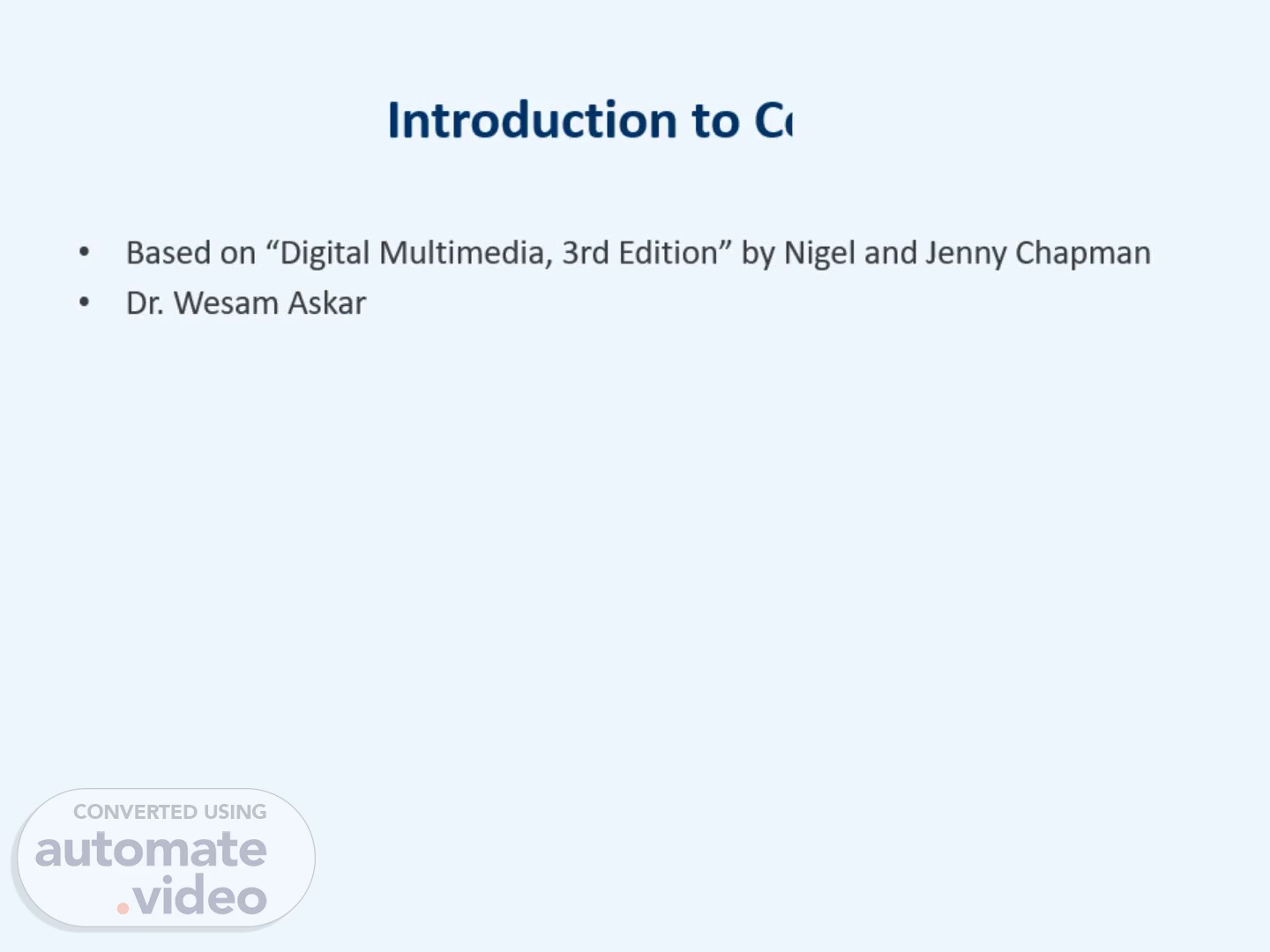Scene 1 (0s)
Introduction to Color. Based on “Digital Multimedia, 3rd Edition” by Nigel and Jenny Chapman Dr. Wesam Askar.
Scene 2 (9s)
What is Color Theory?. A system of rules for combining colors to: - Create visually pleasing mixtures - Maximize readability - Convey meaning through cultural associations.
Scene 3 (19s)
Types of Color Theories. - Additive Theory (Light) - Subtractive Theory (Pigment).
Scene 4 (26s)
Additive Theory Overview. - Black = absence of light - White = all light - Primary colors: Red, Green, Blue (RGB) - Used in TVs, theater lighting, monitors, video production.
Scene 5 (38s)
Subtractive Theory Overview. - White reflects, black absorbs - Primary colors: Cyan, Magenta, Yellow - Used in printing and painting.
Scene 6 (48s)
Color Schemes. Mathematical representations of color: 1. RGB 2. CMY/CMYK 3. HSB/HSI 4. YUV.
Scene 7 (58s)
RGB Color Scheme. - Defines color with R, G, B values - Ideal for CRT and monitors - Maps voltage to each color gun.
Scene 8 (1m 8s)
CMY/CMYK Color Scheme. - Used in printing - Subtractive primaries: Cyan, Magenta, Yellow (+Black) - Inks subtract undesired colors.
Scene 9 (1m 17s)
HSB/HSI Color Scheme. - Triplet values: Hue, Saturation, Brightness/Intensity - Hue: Dominant wavelength - Saturation: Color purity - Brightness: Luminance.
Scene 10 (1m 28s)
Hue. - Sensation produced by light wavelength - Ranges from 0° to 360° on a color wheel.
Scene 11 (1m 37s)
Saturation. - Color intensity (pure vs dull) - 100% = vivid, 0% = gray scale.
Scene 12 (1m 44s)
Intensity / Brightness. - Measure of reflected/emitted light - Human eyes detect brightness better than color.
Scene 13 (1m 53s)
HSB Adjustments. Example of varying: - Saturation - Brightness.
Scene 14 (2m 0s)
YUV Color Scheme. - Used in NTSC, PAL, SECAM TVs - Y = brightness - U/V = color (chrominance).
Scene 15 (2m 9s)
YUV Details. - Advantage: Reduced data for TV signals - Disadvantage: Limited color range on TV vs computers.
Scene 16 (2m 19s)
Color Palettes. - CLUTs define pixel colors - Paint programs use palettes - 256 shades/channel = 16+ million colors.
Scene 17 (2m 27s)
Palette Flashing Problem. - Switching images with different palettes causes flashing - Solutions: * Use a single palette * Fade to black/white between images.
Scene 18 (2m 37s)
The Color Wheel. - Purpose: * Select complementary and contrasting colors - Describes colors by: * Hue * Saturation * Value.
Scene 19 (2m 46s)
Color Wheel - Saturation. - Saturated = vivid - Unsaturated = dull - No saturation = grayscale.
Scene 20 (2m 54s)
Color Wheel - Value. - Lightness/darkness of color - Represents contrast between white and black.
Scene 21 (3m 2s)
Color and Visual Display. - Use color and luminance for: * Search tasks * Shape identification.
Scene 22 (3m 10s)
Hue and Shape Combinations. - Fill and shape influence region recognition - Brightness aids in search and detail detection.
Scene 23 (3m 19s)
Text and Background Color. - Readability is key - Best: Dark text on light background - Avoid poor contrast combinations (e.g. red-green).
Scene 24 (3m 30s)
Contrast in Text. - High contrast = better visibility - Example: Black on white vs Blue on black.
Scene 25 (3m 38s)
Bad Contrast Examples. - Poor contrast can cause eye strain - 'Simultaneous contrast' causes vibration (e.g., red on blue).
Scene 26 (3m 48s)
Verbal Color Contrast. - Contrast highlights importance - Use strong color differences for focus areas.
Scene 27 (3m 56s)
Practical Example. - Orange text box contrasts well with clothing colors - Blue text box blends in, reducing impact.
Scene 28 (4m 5s)
Dithering. - Converts colors to closest match in target palette - Used in low-color environments.
Scene 29 (4m 14s)
Color Dithering. - Needed when display can't support full 24-bit color - Software adjusts colors for appearance.
Scene 30 (4m 22s)
Dithering Algorithms. - Colors replaced with best available matches - Quality depends on the dithering method used.
